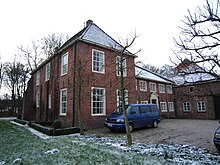Krüsselwarck
The Krüsselwarck (also Krüsselwark , Krüßelwarck , Krüßelwark or Kreuzelwerk is called), the front transverse building a three-part, the late Middle Ages , Frisian farmhouse .
description

The three-part farmhouse is built in the head-neck-torso design, with the front part of the building facing the adjoining parts of the building, resulting in a T-shaped overall floor plan.
Derived from the cross shape of the assembly, the house was given the name "Krüsselwarck", which means something like "Kreuzwerk". Johannes Cadovius-Müller coined the term. He was pastor in Stedesdorf near Esens in East Frisia from 1675 to 1725 and documented this type of house in his handwritten notes from 1691.
The three building parts of the farmhouse are:
- Krüsselwarck - the cross-standing stone house in which the representative living rooms were housed
- Middelhus - the middle house between the stone house and the farm buildings; it contained the entrance area and mostly the large kitchen.
- Veehus - the adjoining farm building with cattle shed, hay and granary
The farmhouse type emerged from the middle of the 17th century. The Gulfhaus, known today, developed from it in several stages .
literature
- Maas, Karl: Steenhus and Krüsselwark in East Friesland and in Jeverland. A contribution to the history of the development of the Frisian farmhouse. Braunschweig 1942.
Web links
- Rüther, Wolfgang: House building between national and economic history. The Krummhörn farmhouses from the 16th to the 20th century (PDF; 1.9 MB)
- Volker Glänzer: The Gulfhaus in East Friesland - an innovation of the 16th and 17th centuries (PDF; 5.0 MB)
Individual evidence
- ^ Wolfgang Rüther: House building between national and economic history. The farmhouses of the Krummhörn from the 16th to the 20th century , page 97 (PDF; 1.9 MB), accessed on October 2, 2013
- ^ Wolfgang Rüther: House building between national and economic history. The farmhouses of the Krummhörn from the 16th to the 20th centuries , page 19 (PDF; 1.9 MB), accessed on October 2, 2013
- ^ Wolfgang Rüther: House building between national and economic history. The Krummhörn farmhouses from the 16th to the 20th centuries , page 83 ff. (PDF; 1.9 MB), accessed on October 2, 2013